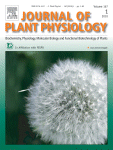Ver ítem
- xmlui.general.dspace_homeCentros e Institutos de InvestigaciónCIAP. Centro de Investigaciones AgropecuariasInstituto de Fisiología y Recursos Genéticos VegetalesArtículos científicosxmlui.ArtifactBrowser.ItemViewer.trail
- Inicio
- Centros e Institutos de Investigación
- CIAP. Centro de Investigaciones Agropecuarias
- Instituto de Fisiología y Recursos Genéticos Vegetales
- Artículos científicos
- Ver ítem
Are Sunflower chlorotic mottle virus infection symptoms modulated by early increases in leaf sugar concentration?
Resumen
Symptom development in a susceptible sunflower line inoculated with Sunflower chlorotic mottle virus (SuCMoV) was followed in the second pair of leaves at different post-inoculation times: before symptom expression (BS), at early (ES) and late (LS) symptom expression. Sugar and starch increases and photoinhibition were observed as early effects BS, and were maintained or enhanced later on, however, chlorophyll loss was detected only at LS. Photoinhibition
[ver mas...]
Symptom development in a susceptible sunflower line inoculated with Sunflower chlorotic mottle virus (SuCMoV) was followed in the second pair of leaves at different post-inoculation times: before symptom expression (BS), at early (ES) and late (LS) symptom expression. Sugar and starch increases and photoinhibition were observed as early effects BS, and were maintained or enhanced later on, however, chlorophyll loss was detected only at LS. Photoinhibition correlated with a drastic decrease in D1 protein level. The progress of infection was accompanied by decreasing levels of apoplastic reactive oxygen species (ROS). In infected leaves, higher antioxidant enzyme activities (superoxide dismutase, SOD; ascorbate peroxidase, APX; glutathione reductase, GR) were observed from BS. The purpose of this work was to evaluate whether the early increases in carbohydrate accumulation may participate in SuCMoV symptom expression. Similar effects on photoinhibition, apoplastic ROS generation and antioxidant activity were generated when healthy leaves were treated with sugars. These results suggest that photoinhibitory processes and lower apoplastic superoxide levels induced by SuCMoV infection may be modulated by sugar increases.
[Cerrar]

Fuente
Journal of Plant Physiology 167 (14) : 1137-1144 (September 2010)
Fecha
2010-09-15
Editorial
Elsevier
ISSN
0176-1617
Formato
pdf
Tipo de documento
artículo
Palabras Claves
Derechos de acceso
Restringido
 Excepto donde se diga explicitamente, este item se publica bajo la siguiente descripción: Creative Commons Attribution-NonCommercial-ShareAlike 2.5 Unported (CC BY-NC-SA 2.5)
Excepto donde se diga explicitamente, este item se publica bajo la siguiente descripción: Creative Commons Attribution-NonCommercial-ShareAlike 2.5 Unported (CC BY-NC-SA 2.5)

